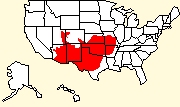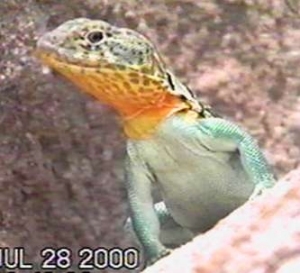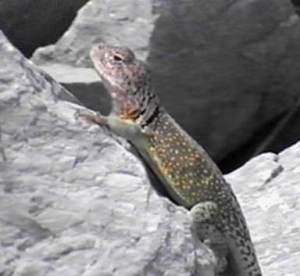|
Eastern Collared Lizard
|
- Order: Squamata (scaled reptiles)
- Suborder: Lacertilia (=Sauria) (lizards)
- Family: Iguanidae (iguanid lizards)
- Subfamily: Crotaphytinae (collared and leopard
lizards)
- Genus: Crotaphytus (collared lizards)
|
| Also known as: mountain
boomer |
Scientific Name: Crotaphytus
collaris collaris (Say, 1823) |
| Habitat: A variety of
habitats from forest to prairie to desert, provided ample rocky
cover is present. |
krotaphos="temples/sides of
head," phyton="creature," collaris="collared"
|
| Length: To 14 inches total. |
|
| Food: Just about
anything it can fit in its mouth, including insects, arachnids,
other lizards, and small mammals. |
 |
| Collared lizards have to be one
of my favorite lizards. They are the state reptile of
Oklahoma and I grew up observing, catching, and keeping these
large, active lizards. Collared lizards are often called
"mountain
boomers" in Oklahoma, presumably because the old pioneers
on their way to California in the 19th century associated the
lizards with unknown noises coming from the hills. Since
collared lizards are usually seen basking on prominent boulders
and on rocky hillsides, this was understandable, although we now
know they are incapable of making any noise other than hissing
when threatened. |
|
| Collared lizards are sexually
dimorphic, meaning the males look different than the
females. Males are usually much more brightly colored,
ranging from dark to light green to a beautiful cobalt blue in
some locales. Females are typically varying shades of brown
with red markings during the breeding season. |
|
| These lizards are interesting to
watch. Males are territorial. Their powerful legs come
in handy when hopping from rock to rock, and they can even run on
their hind legs for short distances, like little dinosaurs.
Collared lizards use burrows or crevices in rocks for hiding,
laying eggs, and sleeping. I have found piles of droppings
just outside the burrows--they use the same location as a
"toilet" repeatedly rather than just going wherever the
mood strikes. |
 |
| This first picture is of a
beautiful male just outside the visitors center at the Wichita
Mountains National Wildlife Refuge. We had to wait a
couple of hours for the lizards to leave their burrows for the
day's activities--it had been cloudy, rainy, and cool all
morning. The male collared lizards in the Wichita Mountains
region (west central Oklahoma west into Texas) exhibit this
beautiful cobalt blue, with bright orange heads/throats.
NOTE: The picture is unretouched! |
|
|
The next picture is of another male, but this time the
locale is the dam at the Fort Cobb Reservoir. You can see
the variance in coloration at this locale less than 100 miles from
the Wichita Mountains. These males were all green to almost
yellow in appearance. The dam's rocky construction provides
a unique setting to study these lizards. Although it was
mid-afternoon in late July and some of the lizards were visibly
gaping (sitting with their mouths open to cool off), the males
were still perched, bodies held high above the hot rock surfaces,
in survey of their territories. Individual territories
appeared to consist of about 100-150 linear feet of dam (the dam
was about 50-75 feet from base to top, so each lizard held a
territory of 5,000 to 11,250 square feet). |
 |
| I have a gallery of many more
collared lizard pictures at my business website, Mountain
Boomer Music. |
|